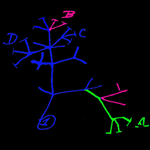params for the phylogeny explorer web application
| width: 550 | in pixels |
| height:800 | in pixels |
| alignName:true |
true or false? are names aligned or adjacent to tips |
| lateralise:false |
true or false? sort the tree by clade branch length |
| levelsToShow:5 | how deep to show? Clades deeper than this are collapsed to a small triangle that can be expanded on demand. |
| branchMultiplier:1 | multiplier for branches. Useful for very small or very big branch lengths. |
| firstCharacter: 'moisture' | The name of the first character/trait
that will appear by default on the tree. The name must
also be in the charJSON. |
| Node: { height: 40, width: 20, type: 'circle', dim: 5, color: '#aaa', overridable: true, align: 'left' } |
configurable attributes of clades (tree
nodes) |
|
Canvas: { background: { color: '#EEF2F7' } |
configurable attributes of the web
application Canvas |
| Edge: { type: 'line', color: '#000', overridable: true, lineWidth: 2 } |
configurable attributes of the lines that
make up the phylogenetic tree visualisation |
... tree and characters
| tree : 'a newick formatted
phylogeny' |
A newick formatted tree. Enclosed in single quotes with no "special characters" (double quotes and such like unless they are escaped. ... other tree formats are possible but not yet |
| character: charJSONcharacters |
see about
charJSON |
... template for simple name based data-sources
It may look daunting but the tmpl variable provides a
simple way to include data resouces which provide taxon name
based searches.
There is no standard form of call for the biodiversity web
services. This template is suited for those that return
results that can be displayed without parsing by browsers.
Some biodiversity web services return json and xml, in which
case, the result needs to be parsed before it can be
displayed. The functions presentClade, onPresentClade,
and Tips can be respecified to achieve this. The getting started with phyloJIVE lists
some examples.
It is essentially a html table that is expanded as required to add the taxon names.
| tmpl : |
the name of
the template |
| '<table style="border:
none"><tbody><tr><th></th><th>links</th><th>
</th><th> </th><th>
</th><th> </th></tr>' + '<% _.each(nodeList , function( value ) {' + |
the header row |
|
'<td><a href="http://THE_First_Resource/<%=
value.name %>"
title="<%= value.name %>
some descriptive text for the
tool tip" rel="<%= value.rel %>"
class="thumbImage1"><%= value.name
%></a></td>' + |
link to the resource
in first column which includes the name of the
taxon |
|
'<td><a
href="http://Another_Resource/<%=
value.name %>" title="about <%= value.name%> some
descriptive text for the tool tip"
rel="<%= value.rel %>"
class="thumbImage1"><id="thumb1"><div
class="forward"></div>
</id="thumb1"></a></td>' + |
a resource which
requires a full name. link is shown as an icon |
| '<td><a href="http://Another_Resource/<%=
value.genus %>+<%= value.species %>" title="some descriptive text for the
tool tip on <%= value.name %>" rel="<%=
value.rel %>"
class="thumbImage1"><id="thumb1"><div
class="forward"></div>
</id="thumb1"></a>' + |
a resource which requires a genus and species separately. link is shown as an icon |
| '%></tbody></table></div>'
|
closing |
Here is an example which includes links to
- DiscoverLife,
- The Encylopedia of Life,
- The Australian Faunal Directory,
- Atlas of Living Australia Species page,
- The National Species List Nomenclator,
- and maps of taxon density and occurence from the Atlas of Living Australia.
tmpl : '<table style="border:
none"><tbody><tr><th></th><th>links</th><th>
</th><th> </th><th>
</th><th> </th></tr>' +
'<% _.each(nodeList , function( value ) {' +
' %> <tr>'+
'<td><a
href="http://www.environment.gov.au/biodiversity/abrs/online-resources/fauna/afd/taxa/<%=
value.name %>" title="<%= value.name %> in the AFD"
rel="<%= value.rel %>" class="thumbImage1"><%=
value.name %></a></td>' +
'<td><a
href="http://bie.ala.org.au/species/<%= value.name %>"
title="about <%= value.name %> ALA species page "
rel="<%= value.rel %>"
class="thumbImage1"><id="thumb1"><div
class="forward"></div>
</id="thumb1"></a></td>' +
'<td><a
href="http://biodiversity.org.au/name/<%= value.name
%>" title="about <%= value.name %> in NSL
nomenclator " rel="<%= value.rel %>"
class="thumbImage1"><id="thumb1"><div
class="forward"></div>
</id="thumb1"></a></td>' +
'<td><a
href="http://www.discoverlife.org/mp/20q?search=<%=
value.name %>+<%= value.species %>" title="images
and info from Discover Life on <%= value.name %>"
rel="<%= value.rel %>"
class="thumbImage1"><id="thumb1"><div
class="forward"></div>
</id="thumb1"></a>' +
'<td><a
href="http://biocache.ala.org.au/ws/density/map?q=<%=
value.name %>" title="<%= value.name %> Aus density
Map (if sufficient samples)" rel="<%= value.rel %>"
class="thumbImage1"><id="thumb1"><div
class="forward"></div></id="thumb1"></a></td></td>'
+
'<td><a
href="http://eol.org/search/show?q=<%= value.name
%>&type[]=taxon_concept&type[]=image&commit=Filter"
title="images of <%= value.name %> in EOL" rel="<%=
value.rel %>"
class="thumbImage1"><id="thumb1"><div
class="forward"></div>
</id="thumb1"></a></td></tr> <%
}); ' +
'%></tbody></table></div>'
.. alternative functions
Alternative functions which define actions on hover and click on nodes and clades
presentClade to replace underscores with spaces
in taxon names
presentClade: function (clade) {
var tmpl = st.config.tmpl,
nodeList = [],
node, html, split;
for (var i = 0; ((i < clade.length) & (i < 30));
i++) {
node = {}
node.name = clade [ i ].name;
node.plus = clade [ i ].name.replace(/\s+/g,'+');
split = node.name.split( /\s+/ );
if ( split.length > 1 ){
node.genus = split [ 0 ];
node.species = split [ 1
];
} else {
node.species = split [ 0 ];
}
node.rel = node.species + '' + i;
node.index = i;
nodeList.push ( node
);
}
if ( tmpl ) {
tmpl = _.template ( tmpl );
html = tmpl ( {nodeList: nodeList});
} else {
}
return html;
}, //presentClade
GUID's (LSIDs)
An example where GUIDs are used (Hornworts
plus LSIDs). Taxon names are looked up with a nomenclator
then translated to the equivalent LSID.
Strictly speaking any GUID's should be supplied with the
phylogeny Or the creator of the phylogeny should explicitly
state that they are using the taxon concepts as recorded
in a particular source at a particular time. However, such
perfection is rarely attainable. This template is provided as
a proof of concept.
